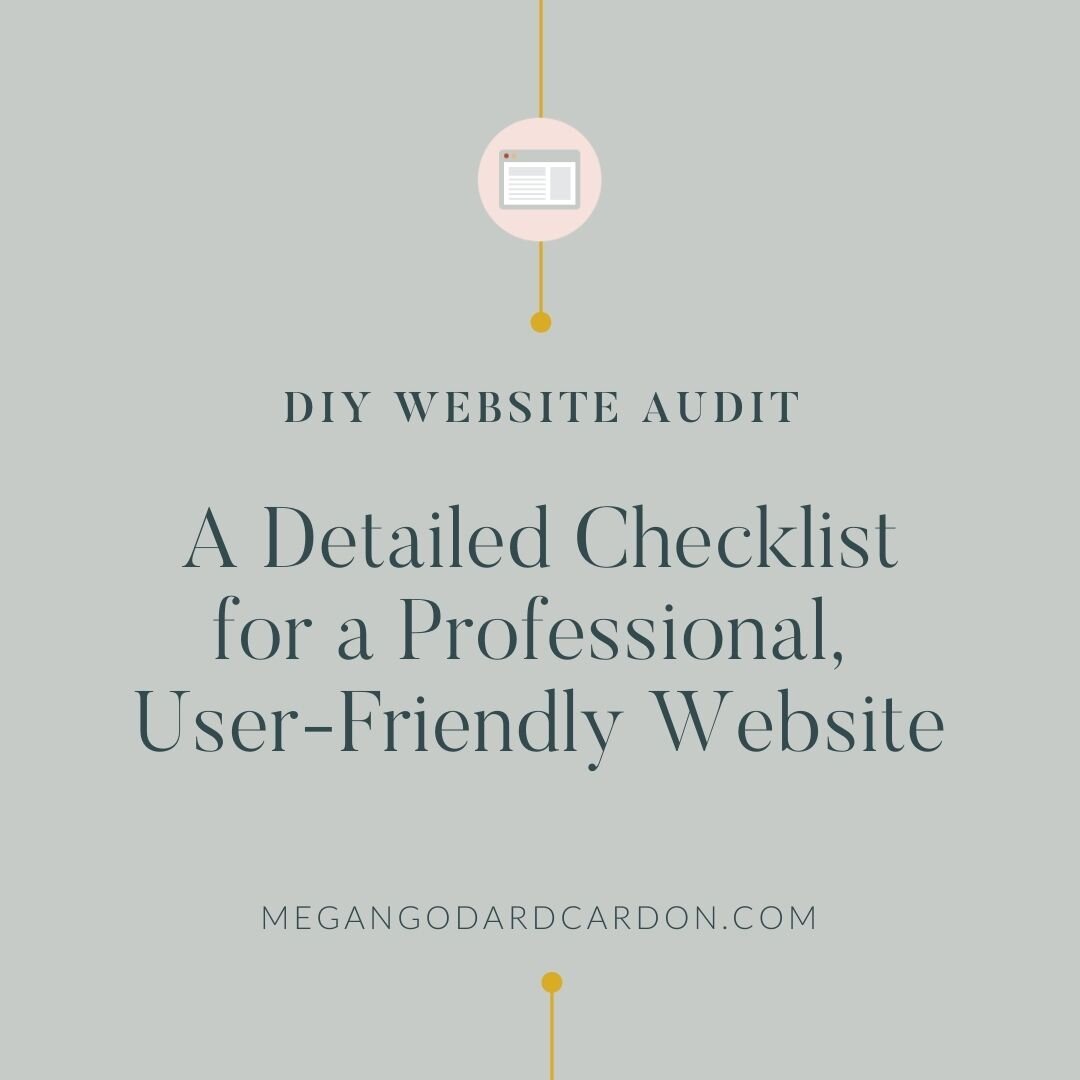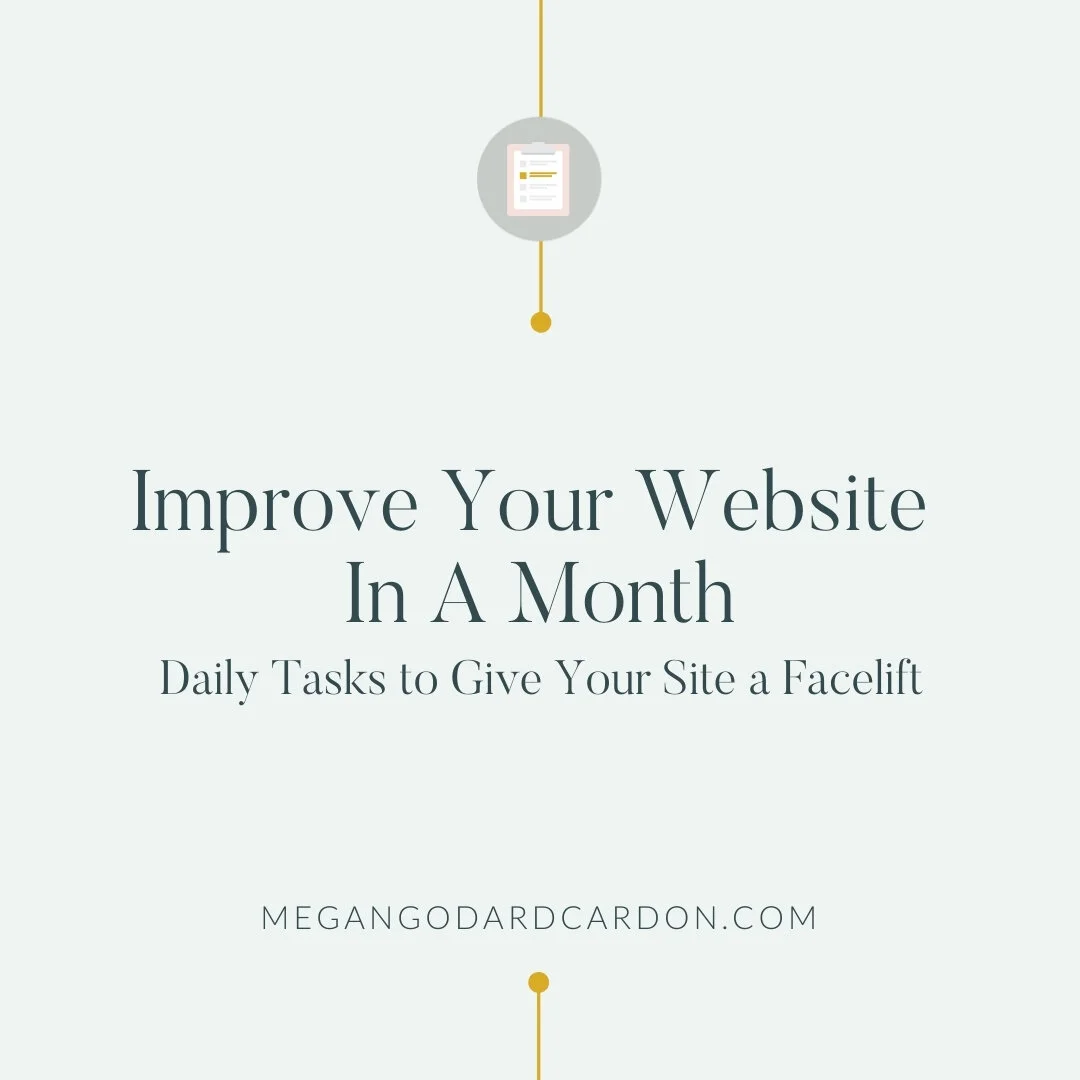DIY Website Audit
When new entrepreneur friends find out I’m a website designer, they often cringe and say, “Don’t look at my website.” Sound familiar? Do you lack confidence in your website? Maybe you built it yourself and just aren’t sure if you did a good job. Or maybe your website is way out of date and no longer fits your brand. It’s not doing you any favors, you’re embarrassed to even send people to your site and maybe you’re hoping they don’t look you up online.
If you’re behind your screen starting to sweat even thinking about your website, I got you. I’m here to lay out exactly what makes a website look professional and user-friendly so you know exactly what could make your website better.
I’ve put together a thorough checklist that goes along with this blog post so you can evaluate your own website. It’s a great start to knowing what could improve the usability and aesthetics of your website. CLICK HERE TO DOWNLOAD THE FREE WORKBOOK.
Now that you’ve downloaded your Ultimate Checklist for a Professional, User-Friendly Website (aka a DIY Website Audit), (if you haven’t yet, click here), let’s dive in.
As I’ve shared in a previous post, research indicates visual attractiveness and usability of a website have a significant relationship with people’s trust in the company. In other words, its important for your website to be easy-to-use and beautiful to show people you’re legit. “But how?” you may be wondering.
I’m going to break it down into five sections: 1) Messaging & Layout, 2) Responsiveness, 3) SEO, 4) Design, 5) Content. Use the checklist and this post to see how your website stacks up in terms of usability and professionalism.
Messaging & Layout
The minute people land on your website, they should be able to tell what you do, for whom, and how to get it.
What to Include in the Header
The layout of the website should be intuitive to navigate - with a simple menu both at the top and bottom. Only the most important pages should get a starring role in the top navigation (ideally less than 6 options). Site visitors already made the decision to visit your website. Keep other decisions to a minimum. And unless you have a big E-Commerce website such as J-Crew, avoid using drop-downs in the main navigation. Again, keep the decisions to a minimum.
What to Include in the Footer
Some website visitors like to scroll straight to the bottom of the webpage looking for a site index or directory. The footer menu should help them quickly find what they’re looking for, so this is a good spot to link to all the main pages of your website. The footer is also a great place to link to Frequently Asked Questions and Company Policies (such as your privacy and cookie policy - which are important for GDPR compliance). This is also a good spot to include links to your social media accounts so that customers can engage with you on other platforms.
What to Include on Every Page
Every page should have a distinct purpose and a clear call to action. Take down any pages that are unfinished or blank, as they give off an unprofessional, newbie kind of vibe (not to mention, they’re not great for SEO). Make sure each page is current and complete. Build credibility and social proof with testimonials peppered around on every page. Not everyone checks a “Testimonial Page,” so make sure they aren’t missed by including some on multiple pages of your website.
Responsiveness
Responsiveness refers to how your website looks on various screen sizes. Since mobile accounts for nearly 50% of website traffic worldwide, it’s critical that your website is mobile device friendly.
Your website should look good and load quickly both on a desktop computer and on a mobile phone or device. The text should be legible in both desktop and mobile view. All the content, forms and buttons should work both on desktop and mobile device.
SEO
SEO stands for Search Engine Optimization. It’s the practice of making web pages more attractive to search engines to increase the quality and quantity of traffic through organic search engine results. In simple terms, it’s all about trying to get your website to show up on the first page of Google when people search for your type of organization.
There’s a lot of strategy involved with SEO, a lot of which involves posting regular content focused around specific, strategic keywords. It’s a long game. This checklist is not an exhaustive list and won’t guarantee you’ll move up to the first page on Google. But there are some simple things you can do to make your website more appealing to search engines.
Get a Custom Domain
First, you’ll want to get a custom domain, ie NOT yourbusinessname.squarespace.com or yourbusinessname.WIX.com or yourbusinessname.blogspot.com. Instead, purchase a custom domain such as: yourbusinessname.com or yourbusinessname.org, etc.
Secure Site with SSL Certificate
Next, make sure your website is secured with an SSL certificate so that your website visitors can access your website via a secure connection.
What is an SSL? SSL, (aka Secure Sockets Layer) is a technology that encrypts the connection between a website and a browser and securely transmits information (such as logins) to prevent unauthorized parties from eavesdropping, altering data, or impersonation.
Furthermore, it may help your SEO. In 2014, Google announced that SSL secured websites would potentially earn a rankings boost in the search results. Finally, it can also help with site-loading times.
Make Sure Your Site Loads Quickly
Fast site loading is important for SEO and for your users. Make sure your website loading time isn’t lagging with large images, files or cumbersome code. A good way to check your site loading speed and other site performance statistics is by using a website grader such as this one. Just type in your website domain and see how your website performs.
Optimize Your Images for Web
One way to improve site loading time, is to make sure all images are optimized for the web (<500kb image file size). Blog posts and pages with images rank higher than those without. So make sure to include relevant images on your web pages & blog posts. Search engines can’t “read” images, so it’s important to add alt text with a description for each image. This also helps individuals using a text reader, by providing a description of the image.
Use Ads & Pop-ups Sparingly & Strategically
Ads and pop-ups can affect your SEO. Too many pop-ups and ads aren’t great for the user experience. And mobile pop-ups may be penalized by search engines. So make sure any pop-ups on your website are easy to click out of and be very selective and strategic when adding pop-ups and ads to your website.
Keep URLS Short
Another helpful tip for SEO, is to keep your URLs short. This is especially important for blog posts. Avoid using dates and categories in your URLs, and if your post title is long, create a shortened version for your URL. For example, instead of domain.com/twenty-outfits-to-rock-in-the-fall, use: domain.com/fall-outfits.
Add Meta Descriptions
Adding meta descriptions to your website is another SEO strategy. Meta descriptions are short bits of text that describe the content of a website or webpage. This is the little bit of descriptive text you’ll see under a website title in search results. While you can’t completely control that your meta descriptions will show up the same in every search result, adding your own helps to influence the description that shows up under the title when your site comes up in search results on Google.
Google cuts off the description at around 160 characters, so it’s best to keep these descriptions short and relevant. This is a great spot to add in some keywords that match the search terms people use to find websites like yours. That being said, avoid “keyword stuffing” - which is when you just shove every keyword into the description and the sentence doesn’t even make any sense. For one, it is off-putting for visitors, and two, search engines often penalize sites that keyword stuff. Instead, use keywords in a way that makes sense in the sentence, rather than write a long stream of nonsensical keywords.
When it comes to writing these meta descriptions, first consider what your target audience is searching for and what problems they have. Then, write an inviting description that explains how your site/page provides the answer to that problem. You want these descriptions to encourage people to click on your site.
Include Your Business Address
Finally, include your business address on your contact page to help search engines know your business is legitimate. (If you operate your business from home, consider using a PO box instead - I don’t recommend adding your home address.)
Design
It’s important the design and aesthetics of your website match the design and aesthetics of your brand to encourage brand recognition.
Logo
At the top of your website, add your logo or a site title that matches your brand name that can be seen on every page and on mobile view. Also, add a custom favicon that represents your logo on the browser tab.
Consistent Color Palette & Fonts
Stick with a consistent color palette throughout your website, using your brand colors. Don’t go wild with a bunch of different fonts on every page. Choose 2-3 complementary fonts (ideally, the same fonts you use on the rest of your brand materials) and stick to those all throughout your website. A consistent color palette and font pairing looks cohesive and professional. Speaking of fonts, make sure your fonts and font-size are legible and easy to read.
Paragraphs
Make sure the lines of text on your website do NOT span wall-to-wall. It’s difficult to read. Limit each line to less than 75 characters on average and add blank space on either side of the text. Also, keep paragraphs left-aligned. Though it’s fine to center-align short pieces of text, center-aligned paragraphs are difficult to read. Left-aligned paragraphs not only look better, but they’re easier to read than center-aligned paragraphs.
Thick sections of text is overwhelming for web visitors. Headings, bullet points and paragraph breaks help to break the text up into manageable, bite-size pieces. You can also use customized icons to help break up the text and visually represent steps or ideas on your website. The messages on your website will inevitably vary in level of importance. Use size and color to help important messages stand out.
White Space
White Space is an essential component of your website design. White space refers to any blank space between graphics, text, or photos. Your eyes need room to breathe! A site that utilizes space is SO much easier to read and more aesthetically pleasing.
Photos
Now let’s talk photos. The images on your website can make or break your website. It’s pretty much impossible to have a gorgeous website with crappy photos. Make sure the photos on your website are high quality and relevant to your brand and message. I’ve got a whole blog post about it here.
Content
Copy
When it comes to the words on your website (aka the copy), keep it clear and easy to understand. Clear is better than clever when it comes to copy. And this is basic for sure, but bares repeating - take care to remove any typos or grammar errors in your copy.
Creating Content
Search engines and humans alike prefer current, relevant, consistent content. Therefore, aim to create valuable, quality content on a regular basis. If blogging is your content of choice, take note that longer posts (1700+ words) with quality content (no keyword-stuffing) tend to rank better in search engine results. Therefore, when creating content, be thorough and genuinely helpful.
Backlinks
Plus, thorough, helpful content will help you build organic backlinks. Have you heard about backlinks? Basically, it is when other reputable websites link to your website. This is SUPER important for SEO. This is a long game that requires creating valuable content that other websites genuinely want to share.
Other ways to build backlinks is guest posting for other relevant websites/blogs or getting featured in online publications. Now, don’t try to cut corners here by buying backlinks, because the Search Engines penalize for bad backlinks. Instead, focus on building quality, legitimate backlinks by creating valuable content.
Internal & External Linking
It’s helpful to include both internal and external links in each blog post. Internal links are links to your own previously posted content. Try to aim for 2-3 internal links in every blog post. But, be sure to add them naturally and keep them relevant. These internal links should be genuinely helpful for the reader and encourage them to stay on your website longer. Search engines like to see websites self-referencing and providing quality value to website visitors.
External links are when you link to external content outside of your website, from reputable websites relating to your topic. Collaboration over competition. Not only are external links helpful for your readers, but search engines may start to associate you with your competitors/peers, which may improve your rankings on certain topics.
When you add internal or external links, be sure to use text links or buttons instead of unsightly URLs with long strings of random symbols.
Keywords & Level Headings
An important part of SEO is including specific, strategic keywords throughout your blog posts and post titles. Also, use level headings (H1, H2, H3, etc) appropriately in order of level of importance. Different level headings are useful to your readers in breaking up the content into manageable, scannable chunks, but it’s also helpful for search engines trying to make sense of your content. And a hot tip: Heading 1 is for titles and so there should really only be one H1 level title on each page.
Categories, Tags, Search Bar & Social Sharing
Labeling each blog post with relevant categories and tags help readers and search engines find content relevant to their search.
Another way to help websites visitors find the content they’re looking for is a search bar tool. It’s so frustrating when you’re on a blog, looking for something specific and the search bar is nowhere to be found! Keep those website visitors happy and on your site longer with an easy-to-find search feature, so they can easily find exactly what they’re looking for!
Finally, provide site visitors an easy way to share your content with Pinterest and social share buttons on images, posts and products.
Where’s Your Website Stand?
Now that you’ve worked through this DIY site audit, where does your website stand? Is it user-friendly and aesthetically pleasing? Could it use some improvements? Take the time to implement these tips and share your website with confidence!
Clueless on How to Make the Changes? I’m here for you.
If you know your site could use some TLC but don’t have the time to implement these changes yourself, I’m your girl! I’ll design a website that ticks all the boxes on this checklist - a website you can share confidently, no cringing necessary.
PS - If you missed the free checklist download above, click here to download it.












